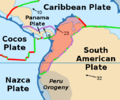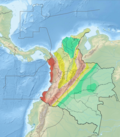Cañasgordas Fault
Etymology
The fault is named after the town of Cañasgordas.
Description
The Cañasgordas Fault is located to the northwest of the city of Medellín. The fault traverses most of the Western Ranges of the Colombian Andes between the towns of Dabeiba and Giraldo in the department of Antioquia. The Cañasgordas Fault probably joins the Mutatá Fault. The fault displaces Cretaceous sedimentary and volcanic rocks, Tertiary sedimentary rocks, and Quaternary mud flows. The fault forms strong linear features on satellite images and aerial photographs and controls the course of the Río Sucio, which has a prominent, linear V-shaped valley. Fault scarps are formed on Quaternary mud flows. The slip rate is estimated at 0.01 to 0.1 millimetres (0.00039 to 0.00394 in) per year deduced from offset of mud flows and the fault was probably active in the Late Pleistocene.
See also
References
- ^ Paris et al., 2000, p.17
- ^ Paris et al., 2000, p.18
Bibliography
- Paris, Gabriel; Machette, Michael N.; Dart, Richard L.; Haller, Kathleen M. (2000a), Map and Database of Quaternary Faults and Folds in Colombia and its Offshore Regions (PDF), USGS, pp. 1–66, retrieved 2017-09-18
Maps
- Paris, Gabriel; Machette, Michael N.; Dart, Richard L.; Haller, Kathleen M. (2000b), Map of Quaternary Faults and Folds of Colombia and Its Offshore Regions (PDF), USGS, p. 1, retrieved 2017-09-18
Further reading
- Page, W.D (1986), Seismic geology and seismicity of Northwestern Colombia, San Francisco, California, Woodward-Clyde Consultants Report for ISA and Integral Ltda., Medellín, pp. 1–200


